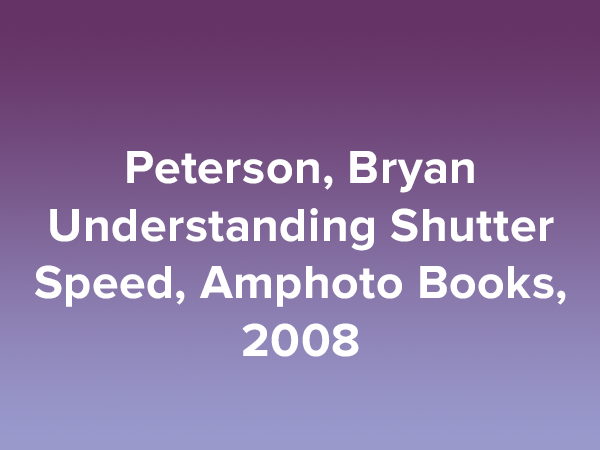Peterson, Bryan; Understanding Shutter Speed, Amphoto Books, 2008
This is another beautifully illustrated book by Bryan Peterson that explains basic photographic concepts, this time about shutter speed, in an easily understandable way. It is the perfect companion to Understanding Exposure and makes a nice complement to that book.

Understanding Shutter Speed is divided into five sections. The first section discusses the six correct shutter speeds and the concept that “you will always attain the fastest possible shutter speed at any given ISO when you use the largest possible lens opening, and you will be able to attain the slowest possible shutter speed at any given ISO by using the smallest possible lens opening.”
The next section is about “Freezing action,” using shutter speeds between 1/250 sec and 1/1000 sec. Generally, in order to freeze action when the subject is coming toward you, 1/250 sec is adequate, but when the subject is moving from side to side or up and down, shutter speeds at between 1/500 sec and 1/1000 sec are needed. “The real key, when possible, is to pre-focus on that spot, that area, where you know the action is headed.”
The chapters about slower speeds begin with making rain using 1/60 sec. and Peterson’s preference for slower shutter speeds because of the greater opportunity to be creative with them. Panning requires shutter speeds at between 1/30 to ¼ sec. and a colorful background. The cotton candy effect with waterfalls or windblown scenes requires ¼ sec or ½ sec. The really slow shutter speeds of 2 to 8 seconds are good for “painting,” a technique where the photographer deliberately moves the camera to create a painted effect which works particularly well with colored backgrounds.
The remainder of the book has tips about zooming, low light and special effects photography. Peterson’s recipe for night photography is to take a meter reading from the sky and use one of the six correct shutter speeds from that reading to shoot the image using the aperture and shutter speed to get the effect you want. “The longer the exposure time, the greater the amount of motion recorded in the image.” To capture lightning a long shutter speed increases the chance of the shutter being open when the lightning occurs.
Understanding Shutter Speed is not the breakthrough book that Understanding Exposure was when it was published, but the two books together are a wonderful foundation to build upon your photographic skills.
